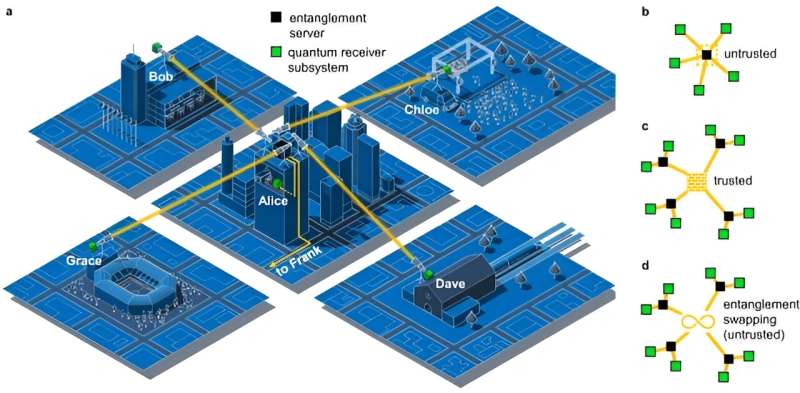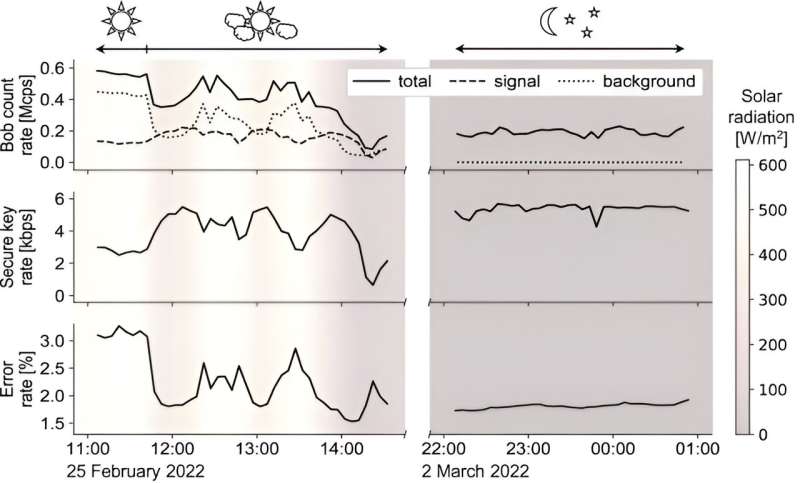October 10, 2023 feature
This article has been reviewed according to Science X's editorial process and policies. Editors have highlighted the following attributes while ensuring the content's credibility:
fact-checked
peer-reviewed publication
trusted source
proofread
Toward metropolitan free-space quantum networks

Quantum communications have rapidly progressed toward practical, large-scale networks based on quantum key distributions that spearhead the process. Quantum key distribution systems typically include a sender "Alice," a receiver "Bob," who generate a shared secret from quantum measurements for secure communication. Although fiber-based systems are well-suited for metropolitan scale, a suitable fiber infrastructure might not always be in place.
In a new report in npj Quantum Information, Andrej Kržič and a team of scientists developed an entanglement-based, free-space quantum network. The platform offered a practical and efficient alternative for metropolitan applications. The team introduced a free-space quantum key distribution system to demonstrate its use in realistic applications in anticipation of the work to establish free-space networks as a viable solution for metropolitan applications in the future global quantum internet.
Quantum communication network
Quantum communication typically aims to distribute quantum information between two or more parties. A series of revolutionary applications of quantum networks have provided a roadmap towards engineering a full-blown quantum internet. The proposed invention provides a heterogeneous network of special purpose sub-networks with diverse links and interconnects. The concept of quantum key distribution networks have driven this development to pave the way for other distributed quantum information processing methods to benchmark the technological maturity of quantum networks in general.
In this work, Kržič and colleagues described a metropolitan free-space network architecture to secure communications at summits, conferences and other events, with the added capacity to complement an already existing network infrastructure in the absence of end-to-end fiber connections. The quantum physicists built the architecture around a central entanglement server to stream the entangled photons to the users of the network.
They built key building blocks of this architecture, including a portable, high-visibility entangled photon pair source suited for metropolitan applications with dedicated filtering for daytime function. The physicists performed quantum key distribution experiments in realistic scenarios across 1.7 km with quantum security to show the capacity to achieve record kilobyte per second rates at night and in broad daylight.

An entanglement-based quantum network
The researchers developed a network architecture wherein an entangled photon source facilitated the server to stream entanglement into a metropolitan-scale network built of free-space links. The scientists opted to place the entanglement server in a central high-rise building.
Each user owned a quantum receiver subsystem to detect the anatomy of a quantum state, and the team readily extended the network size by introducing several entanglement servers interconnected through a central trusted mode to distribute entanglement to the users. The physicists expect the entanglement servers to function as a convenient interface to connect a metropolitan free-space network to the fiber backbone of a larger intercity network.
A free-space quantum key distribution system between Alice and Bob
Kržič and team developed a quantum communication system specific for metropolitan applications that consisted of the key building units necessary to implement a free-space quantum network at a new site in less than a day. The platform did not require prior infrastructure, apart from access to electricity. The system resembled the Alice-Bob segment of the network, where the entanglement servers generated pairs of polarization-entangled photons at 810 nm: One was sent to Alice via a single-mode fiber, while Bob received the other using a free-space link.
The closed-loop stabilization system facilitated long-term functionality, where both Bob and Alice owned a quantum receiver sub-system. Bob's version had specially designed spectral and spatial filtering modules to function at daylight, while Alice's version did not require dedicated filtering of daylight noise. The team realized a classical channel between Alice and Bob's quantum receiver subsystem with commercial radio antennas.

System performance in night and day
The quantum engineers used the system to establish a quantum link between a location in Jena, Germany, and a location of a temporary container on top of a 1.7 km distant public service building. They benchmarked the system performance relative to quantum bit error rate and achievable secure key rate for two experiments at night and day with contrastingly higher background noise. The scientists separated Bob's detected count rates into signal and background noise contributions, including solar radiation measured by a weather station.
The team performed a night experiment on March 2, 2022, to demonstrate a stable performance with a quantum bit error rate of less than 2% for an average secure key rate of 5.4 Kbps across several hours. The performance of the system varied to a greater extent; for instance, when the team exposed the link to direct sunlight the detected noise rates reached values greater than 400 kilocounts of photons per second (kcps). At the next few hours, as small clouds crossed the sun, the background noise reduced to restore the performance of the platform, as a result, it varied in direct consequence of sunlight.
The team simulated a scenario to gauge the performance of two independent free-space links from the entanglement servers to Alice and Bob. At night time, they noted a secure key rate of more than 1.1 kbps. When the team deployed this system in July 2021, they established a free-space quantum key distribution link between two offices located 300 m apart in Bonn, Germany, to achieve similar key rates at night and daytime.
Outlook
In this way, Andrej Kržič and the team developed an entanglement-based, free-space quantum network architecture as a viable solution for metropolitan scales. They achieved up to 5.7 kbps secure rates under varying conditions to indicate its capacity to function 24/7 to facilitate a full coverage of a city.
They further explored high-dimensional entanglement to facilitate higher information capacity per photon with better security and improved robustness to noise. The distribution of entanglement is at the heart of multiple applications beyond quantum key distribution, including quantum clock synchronization and quantum cryptography.
More information: Andrej Kržič et al, Towards metropolitan free-space quantum networks, npj Quantum Information (2023). DOI: 10.1038/s41534-023-00754-0
Sheng-Kai Liao et al, Satellite-to-ground quantum key distribution, Nature (2017). DOI: 10.1038/nature23655
Journal information: npj Quantum Information , Nature
© 2023 Science X Network




















